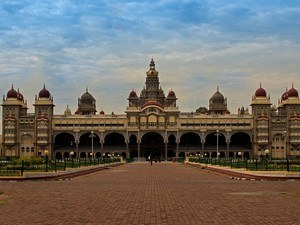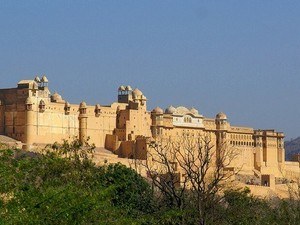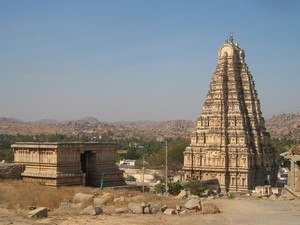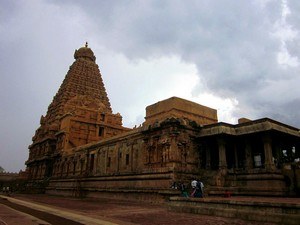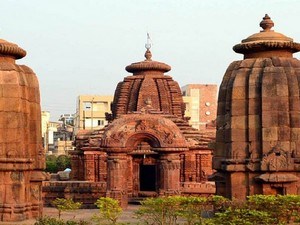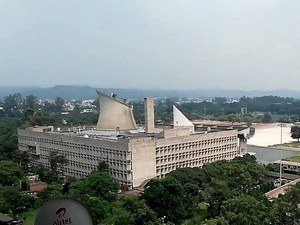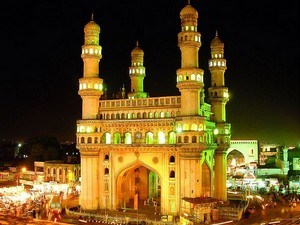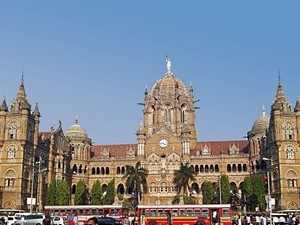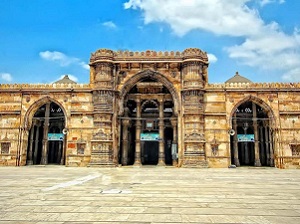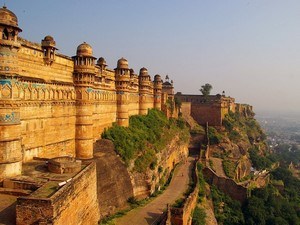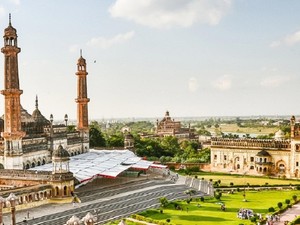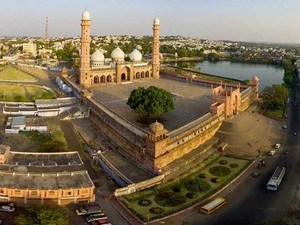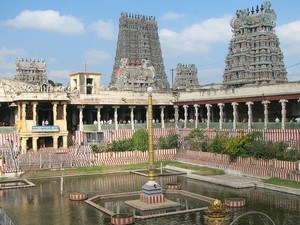1
DAY 1 : TRAVEL TO AGRA & SIGHTSEEING
DAY 1 : TRAVEL TO AGRA & SIGHTSEEING
 Sightseeing
Sightseeing
Leisure / No Sightseeing
At a distance of 6 km from Agra Cantonment Railway Station, Taj Mahal, one of the most popular tourist destinations in the world, is located on the southern bank of the Yamuna River in Agra of Uttar Pradesh State. Taj Mahal was declared as a World Heritage Site by UNESCO in 1983 and it is also counted among the seven wonders of the modern world. It attracts around four million visitors annually. Taj Mahal is the face of Agra Tourism and among the must include place in your Golden Triangle tour packages.
Taj Mahal was commissioned in 1632 by the Mughal emperor Shah Jahan (reigned 1628-1658), in the memory of his favorite wife Mumtaz Mahal. The construction of the monument was completed in 1653. The Taj Mahal was constructed under the supervision of architects Abdul-Karim Ma'mur Khan, Makramat Khan and Ustad Ahmad Lahauri. It took 21 years for the Taj Mahal to be constructed .....
 Duration of visit: 2 Hours
Duration of visit: 2 Hours
 Timings: 6 AM to 6.30 PM. Closed on Friday
Timings: 6 AM to 6.30 PM. Closed on Friday
At a distance of 6 km from Agra Cantonment Railway Station, Taj Museum is one of the most popular museums in Agra and is located in the ground floor of western Naubat Khana, also known as Jal Mahal, with in the Taj Mahal complex.
The museum was established in 1982. It is a double storied building having a quadrangle projection outside and is built on a raised platform. It is a big museum comprising of two floors and has three galleries along with a chief hall. The museum displays various exhibits relating mostly to the construction of the Taj Mahal and to the period of its builders. Totally 121 antiquities are on display, which are broadly categorized as Mughal miniature paintings, manuscripts, government decrees, specimen of calligraphy, arms, utensils, plans and drawings of Taj Complex, paintings, specimen inlay work, marble pillars, etc.
In main hall the paintings of Shah Jahan and his favourite wife Mumtaz Mahal both on ivory, encased in ornamental wooden frame, replicas .....
 Duration of visit: 30 Mins
Duration of visit: 30 Mins
 Timings: 10 AM to 5 PM. Closed on Friday
Timings: 10 AM to 5 PM. Closed on Friday
At a distance of 4.5 km from Agra Cantonment Railway Station and 2.5 Km from Taj Mahal, The Agra Fort, also known as the Lal Qila or Red Fort, is situated on the banks of Yamuna River in Agra, It is among the prime places to visit in Agra City. Uttar Pradesh. The Fort is a UNESCO World Heritage and one of the best forts in India.
Agra Fort was originally a brick fort known as Badalgarh, held by Raja Badal Singh, a Hindu Rajput king (1475 AD). Sikandar Lodi was the first Sultan of Delhi to shift his capital from Delhi to Agra. After Sikandar Lodi died in 1517, his son Ibrahim Lodi held the fort for 9 years until he was defeated and killed in the battle of Panipat in 1526. Several palaces, wells and a mosque were built in the fort during the Lodi period.
After the First Battle of Panipat in 1526, the victorious Babur stayed in the fort, in the palace .....
 Duration of visit: 1 Hour
Duration of visit: 1 Hour
 Timings: 6 AM to 6 PM
Timings: 6 AM to 6 PM
 Overnight Stay in Agra
Overnight Stay in Agra
2
DAY 2 : VISIT MATHURA - VRINDAVAN & TRAVEL TO DELHI
%%Itinerary_Title_Day2%%
 Sightseeing
Sightseeing
About ISKCON Temple / Krishna Balaram Mandir
At a distance of 2 Km from Vrindavan Railway Station, ISKCON Temple is a popular Hindu temple situated in Raman Reti, Vrindavan. Also known as Sri Krishna Balaram Mandir, the temple is dedicated to Lord Krishna. It is one of the temples built by the International Society for Krishna Consciousness abbreviated as ISKCON, a spiritual organization that was established by A.C. Bhakti Vedanta Swami Prabhupada. The temple is one of the top
pilgrimage sites in Uttar Pradesh, and among the most visited places in the holy town of Vrindavan.
History of ISKCON Temple / Krishna Balaram Mandir
The ISKCON Temple in Vrindavan was established in 1975 and officially opened during the significant festival of Ram Navami. The temple's foundation was laid by Swami Prabhupada, the founder of ISKCON. It was the first temple to be constructed by International Society for Krishna Consciousness .....
 Duration of visit: 1 Hour
Duration of visit: 1 Hour
 Timings: 7 AM - 12 PM & 4 PM - 8.30 PM
Timings: 7 AM - 12 PM & 4 PM - 8.30 PM
About Bankey Bihari Temple
At a distance of 1 Km from Vrindavan Railway Station, Sri Bankey Bihari Mandir is a Hindu temple situated near Radhavallabh Temple in the holy city of Vrindavan. The temple is dedicated to Banke Bihari, a form of Lord Krishna. This temple is among the 7 temples of Thakur of Vrindavan, and among the must-include places in the
Vrindavan family packages. The word Banke means bent in three places, while the word Bihari means supreme enjoyer. This is how Lord Kṛiṣhṇa, who is bent in three places, got the name Banke Bihari
History of Bankey Bihari Temple
The presiding deity of the temple is Lord Krishna, and the idol of the deity was originally worshipped by Haridas Swami under the name of Kunji-bihari which means enjoyer of lakes. His disciples bestowed the name Banke Bihari due to the image's tribhaṅga posture. The idol was worshipped in Nidhivan .....
 Duration of visit: 1 Hour
Duration of visit: 1 Hour
 Timings: 7.45 AM - 12 PM & 5.30 PM - 9.30 PM in summer, 8.45 AM - 1 PM & 4.30 PM - 8.30 PM in winter
Timings: 7.45 AM - 12 PM & 5.30 PM - 9.30 PM in summer, 8.45 AM - 1 PM & 4.30 PM - 8.30 PM in winter
About Govind Deo Temple / Govind Dev Ji Temple
At a distance of 1 Km from Vrindavan Railway Station, Govind Deo Temple, also known as Govind Dev Ji Temple, is Hindu temple located in Vrindavan. The temple is dedicated to Govind Dev Ji, a form of Lord Krishna. Also called Radha Govind Dev Temple, it is one of the most impressive Hindu temples in Vrindavan, and among the must-include places in the
Vrindavan pilgrimage packages. Govind Deo Temple has a spiritual atmosphere which mesmerizes its visitors.
History & Mythology of Govind Deo Temple / Govind Dev Ji Temple
The Govind Dev Ji Temple in Vrindavan boasts a profound history, tracing back to the 16th century when Rupa Goswami, a follower of Chaitanya Mahaprabhu, unearthed the deity at Goma Teela. According to the legend, Rupa Goswami encountered a boy who led him to the idol's location, only to vanish afterward. He came to the realization .....
 Duration of visit: 30 Mins - 1 Hr
Duration of visit: 30 Mins - 1 Hr
 Timings: 8 AM - 12.30 PM & 4.30 PM - 8 PM
Timings: 8 AM - 12.30 PM & 4.30 PM - 8 PM
About Dwarkadhish Temple
At a distance of 4 Km from Mathura Junction Railway Station, Dwarkadheesh Temple is a Hindu temple located near the banks of river Yamuna, close to Vishram Ghat and Gatashram Tila in the holy city of Mathura, Uttar Pradesh. The main deity of the temple is Lord Dwarkadheesh, a form of Lord Krishna. This temple is also famous by other names like Jagat Mandir or Nija Mandir. It is one of the oldest and largest temples in Mathura, and among the most visited
pilgrimage sites near Delhi.
History of Dwarkadhish Temple
The Dwarkadheesh Temple in Mathura was established in 1814 by Seth Gokul Das Parikh, who served as the treasurer for the Gwalior State under the Scindia dynasty. A devoted follower of Lord Krishna, he constructed this shrine to honor the deity. The principal deity worshipped at the temple is Lord Dwarkadheesh, a manifestation of Lord Krishna, the ruler of Dwarka, .....
 Duration of visit: 30 Mins - 1 Hr
Duration of visit: 30 Mins - 1 Hr
 Timings: 7 AM - 1 PM & 5 PM - 9.30 PM
Timings: 7 AM - 1 PM & 5 PM - 9.30 PM
BREAK FOR MEALS / HOTEL CHECK-IN | CHECK-OUT / SHOPPING / LEISURE
About Vishram Ghat
At a distance of 4.5 Km from Mathura Junction Railway Station, Vishram Ghat is a sacred bathing ghat situated on the banks of river Yamuna in Mathura. Vishram Ghat is the main ghat of Mathura and is central to 25 other ghats. The Vishram Ghat is one of the most important ghats as the traditional parikrama starts and ends at this place. The parikrama is the circumambulation of all the major religious and cultural places of Mathura, among the most prominent
places to visit near Delhi.
History & Mythology of Vishram Ghat
According to the legend, Lord Krishna is said to have rested at this place after killing Kansa and the name Vishram Ghat is in reference to this as it means 'ghat of rest.' However, the Varaha Purana states that it was Vasudeva who rested at this site, and the ghat is named in his honor.
During the 15th Century, under the rule of the Mughal emperor, this location .....
 Duration of visit: 30 Mins
Duration of visit: 30 Mins
 Timings: Aarti: 7 PM - 7.15 PM in summer & 6.45 PM - 7 PM in winter
Timings: Aarti: 7 PM - 7.15 PM in summer & 6.45 PM - 7 PM in winter
About Mathura Sri Krishna Temple
At a distance of 4 Km from Mathura Junction Railway Station, Sri Krishna Janmabhoomi is the most famous temple located in the crowded city of Mathura. Dedicated to Lord Krishna, the temple is the most important site for the followers of Lord Krishna and among the must-include places in the
Mathura tour packages. Sri Krishna Janma Bhoomi also known as Katra Keshav Dev Temple is the actual birthplace of Lord Krishna. The temple is built around the prison cell in which Lord Krishna's parents, Mata Devaki and Vasudeva were imprisoned by his evil uncle Kansa.
History of Sri Krishna Janmabhoomi Temple
Sri Krishna Janmasthan Temple has been built around the prison in which Lord Krishna was born. It is believed that it was first constructed by the great-grandson of Krishna Vajranabha 5000 years ago. A bigger temple was constructed to replace the old temple during the reign of Emperor .....
 Duration of visit: 1 Hour
Duration of visit: 1 Hour
 Timings: 5 AM - 12 PM & 3 PM - 8.30 PM
Timings: 5 AM - 12 PM & 3 PM - 8.30 PM
3
DAY 3 : DELHI SIGHTSEEING
%%Itinerary_Title_Day2%%
At a distance of 15 km from New Delhi Railway Station, Qutub Minar is the magnificent tower of victory stands in the Qutub Complex located at Aurabindo Marg near Mehrauli in Delhi. Qutub is the highest tower in India and is an UNESCO World Heritage Site. It is among the must visit Delhi tourist places and one of the best heritage sites in Delhi city. It is also commonly featured in the promotion of Delhi Tourism.
Qutub-ud-Din Aibak laid the foundation of Minar in 1199 AD for the use of the Mu'zzin (crier) to give calls for prayer and raised the first storey, to which three more storeys were added by his successor and son-in-law, Shamsud-Din Iltutmish (AD 1211-36). Numerous inscriptions in Arabic and Nagari characters in different places of the Minar reveal the history of Delhi. According to the inscriptions on its surface it was repaired by Firoz Shah Tughlaq (AD 1351-88) and Sikandar Lodi (AD 1489-1517). Major R. Smith also repaired and restored the Minar in 1829.
It is an .....
 Duration of visit: 1 Hour
Duration of visit: 1 Hour
 Timings: 6.30 AM to 6.30 PM
Timings: 6.30 AM to 6.30 PM
At a distance of 15 km from New Delhi Railway Station, Alai Minar is an incomplete monument stands just north of Qutub Minar in the Qutub Complex.
The Alai Minar is a massive structure which was started by Aladdin Khilji in 1311 AD. Sultan Aladdin Khilji, an over ambitious Sultan of the Khilji dynasty, wanted to build a structure that would be double the height of Qutub Minar to commemorate his victory over one of his Deccan campaigns. He also executed the plan and increased the size of the enclosures of the Quwwat-Ul-Islam Masjid by four times its original size to provide a ceremonial entrance gateway on either sides of the mosque. He wanted the Alai Minar to match up with the size of the increased height of the mosque and also wanted a second tower of victory under his name and hence the Alai Minar was initiated.
The construction was completed up to the first storey but unfortunately, the construction was abandoned after the death of Sultan Ala-ud-din Khalji in 1316 AD and .....
 Duration of visit: 15 Mins
Duration of visit: 15 Mins
 Timings: Qutub Complex Timings
Timings: Qutub Complex Timings
At a distance of 15 km from New Delhi Railway Station, Alai Darwaza is a magnificent gateway situated north of Qutub Minar in the Qutub Complex.
The Alai Darwaza was built by Aladdin Khilji in 1311 AD with exquisite inlaid marble decorations and latticed stone panels. The Alai Darwaza was a part of Aladdin Khilji's extension of the Quwwat-ul-Islam mosque. It was one of the four grand gateways built by the Sultan; the other three could not be completed because of the death of Ala-ud-din in AD 1316.
This is the main gateway from southern side of the Mosque. It highlights the remarkable skills of Turkish and local artisans who worked on it. It is considered to be one of the most important buildings built during Delhi Sultanate period. Alai Darwaza is follows the traditional Islamic architectural style. It was built using red sandstone while white marble was used on the exterior walls.
Square in plan and with a large dome on top, Alai Darwaza follows principles of symmetrical .....
 Duration of visit: 15 Mins
Duration of visit: 15 Mins
 Timings: Qutub Complex Timings
Timings: Qutub Complex Timings
At a distance of 15 km from New Delhi Railway Station, Alauddin Khilji Tomb and Madrasa are situated in the Qutub Complex. It was the first structure in India with a tomb standing alongside a Madrasa.
Ala-ud-din's Madrasa is located to the south-west of the Quwwat-ul-Islam Mosque. It was established by Ala-ud-din Khilji, as a college for education on Islamic scriptures and theology. It consists of rooms and halls built around a quadrangular court. Screened walls were originally present on the eastern and western sides of the quadrangular court. On the western side, a group of seven small, cell-like structures are present, which are believed to have served as residents of the teachers and staff. The entry on the north side consists of an elaborately carved doorway.
The central room of the Madrasa, which has Aladdin tomb, has now lost its dome, though many rooms of the structure are intact. Alauddin Khilji was the second Sultan of Delhi from Khilji dynasty, who ruled from 1296 .....
 Duration of visit: 15 Mins
Duration of visit: 15 Mins
 Timings: Qutub Complex Timings
Timings: Qutub Complex Timings
At a distance of 15 km from New Delhi Railway Station, The Iron Pillar is standing at the center of the Quwwat-ul-Mosque in the Qutub Complex.
The Iron Pillar dates back to around 4th century, which was erected for honouring Lord Vishnu and in remembrance of Chandragupta II Vikramaditya (375-413). Based on inscriptions and archaeological evidence, the Iron Pillar of Delhi was originally located in Udayagiri near Vidisha in Madhya Pradesh. It was brought to its current location in 1233 AD by Shams-ud-din Iltutmish during his invasion of Malwa. It was erected as a flag pole and it is still a mystery that how this pillar moved to the present location in Qutub Minar. The pillar also highlights ancient India's achievements in metallurgy.
This pillar is about 7.3 m tall and is made of 98% wrought iron, which has not rusted or decomposed for more than 1600 years. The decorative bell at the top end of the Iron Pillar presents a marvelous design. The next part of the structure is the .....
 Duration of visit: 15 Mins
Duration of visit: 15 Mins
 Timings: Qutub Complex Timings
Timings: Qutub Complex Timings
At a distance of 15 km from New Delhi Railway Station, The Iron Pillar is standing at the center of the Quwwat-ul-Mosque in the Qutub Complex.
The Iron Pillar dates back to around 4th century, which was erected for honouring Lord Vishnu and in remembrance of Chandragupta II Vikramaditya (375-413). Based on inscriptions and archaeological evidence, the Iron Pillar of Delhi was originally located in Udayagiri near Vidisha in Madhya Pradesh. It was brought to its current location in 1233 AD by Shams-ud-din Iltutmish during his invasion of Malwa. It was erected as a flag pole and it is still a mystery that how this pillar moved to the present location in Qutub Minar. The pillar also highlights ancient India's achievements in metallurgy.
This pillar is about 7.3 m tall and is made of 98% wrought iron, which has not rusted or decomposed for more than 1600 years. The decorative bell at the top end of the Iron Pillar presents a marvelous design. The next part of the structure is the .....
 Duration of visit: 15 Mins
Duration of visit: 15 Mins
 Timings: Qutub Complex Timings
Timings: Qutub Complex Timings
At a distance of 15 km from New Delhi Railway Station 2.5 km from Okhla Railway Station, The Lotus Temple is located at Bahapur Hill. Also called Bahai Temple or the Bahai House of worship, the Lotus Temple is one of the major landmarks and among the most visited places of sightseeing in Delhi.
Lotus Temple was found by the believers of the Bahai Faith, an independent world religion, which was founded by Baha'ullah. This temple is an ideal place of meditation which is open to all other faiths. Lotus Temple is so named because of the lotus like structure of the temple. It is one of seven Bahai Houses of Worship in the world and is one of the most visited sites in the world with an average of three and a half million visitors each year.
The temple was designed by Fariborz Shaba, a Canadian architect of Iranian origin. He took 10 years in designing the structure. The construction of the building began in 1980 and was completed in 1986 at a cost of Rs. 10 million and was opened .....
 Duration of visit: 1-2 Hours
Duration of visit: 1-2 Hours
 Timings: 9 AM to 5.30 PM. Closed on Monday
Timings: 9 AM to 5.30 PM. Closed on Monday
At a distance of 8 km from New Delhi Railway Station and 3 km from Hazrat Nizamuddin Station, Humayun's Tomb is one of the prime tourist places to visit in Delhi and one of the top historical places in Delhi city. The tomb is an UNESCO World Heritage Site. It is the final resting place of Humayun, the second Mughal Emperor and father of Akbar.
The construction of this tomb was commissioned by Humayun's wife, Hamida Banu Begum or Haji Begum in 1562. It was designed by Mirak Mirza Ghiyath, a Persian architect. Humayun's tomb was based on Gur-e Amir, the tomb of Mughal ancestor Timur in Samarkand. The tomb was completed in 1572 AD and is believed to have costed 15 lakh rupees at the time of its completion. The entire structure is built using red sandstone.
Humayun's tomb is a fine specimen of the great Mughal architecture, which was inspired by Persian architecture. The tomb was the first garden-tomb on the Indian subcontinent. Its unique beauty is said to have inspired several .....
 Duration of visit: 1-2 Hours
Duration of visit: 1-2 Hours
 Timings: 6 AM to 6 PM
Timings: 6 AM to 6 PM
4
DAY 4 : DELHI SIGHTSEEING
%%Itinerary_Title_Day2%%
At a distance of 3.5 km from New Delhi Railway Station, Jama Masjid or Masjid-i-jahan-Numa is located in the center of old Delhi near the famous Red Fort. This is one of the largest mosques in India and one of the last monuments built by Mughal Emperor Shah Jahan. It is one of the top places to visit in Delhi city and also among the top historical sites in Delhi.
Jama Masjid was commissioned by Shah Jahan between 1644 and 1656 at a cost of 1 million rupees. This mosque was constructed with the efforts of more than 5,000 workers. The Masjid was completed under the supervision of Saadullah Khan, the Prime Minister of Shah Jahan and was inaugurated by an imam from Bukhara, present-day Uzbekistan. After the British victory in Revolt of 1857, they occupied the mosque and stationed their soldiers here.
The mosque has three large gates, four towers and two 40 m high minarets constructed using red sandstone and white marble. The mosque is built on a red sandstone porch, which is about .....
 Duration of visit: 1 Hour
Duration of visit: 1 Hour
 Timings: 7 AM to 12 PM and 1.30 PM t0 6.30 PM
Timings: 7 AM to 12 PM and 1.30 PM t0 6.30 PM
At a distance of 4 km from New Delhi Railway Station, The Red Fort or the Lal Qila is one of the best historical places in Delhi situated on the western bank of the River Yamuna. This grand fort is a UNESCO World Heritage Site in Delhi, from where the prime minister addresses the nation every year on Independence Day (15 August). It is located in the center of Delhi and houses a number of museums. It is one of the best places to visit in Delhi and also one of the top attractions you must include in Golden Triangle tour.
The Red Fort was built by Shah Jahan between 1638 and 1648. The Fort was built when Shah Jahan transferred his capital from Agra to Delhi. The fort is better planned than the Agra Fort and was the residence of the Mughal emperor of India for nearly 200 years, until 1857. It was originally called as Quila-i-Mubarak, meaning the blessed fort, as it was the royal .....
 Duration of visit: 2 Hours
Duration of visit: 2 Hours
 Timings: 6 AM to 6 PM on all days. Closed on Monday.
Timings: 6 AM to 6 PM on all days. Closed on Monday.
At a distance of 5 km from New Delhi Railway Station, Raj Ghat is a memorial dedicated to the Father of the Nation, Mahatma Gandhi located on the banks of Yamuna River in Old Delhi.
Raj Ghat is the last resting place of Mahatma Gandhi. The cremation of Mahatma Gandhi took place at the Raj Ghat on 31st January 1948, a day after his assassination. The memorial was designed by Vanu G. Bhuta, who intended it to reflect the simplicity of the Mahatma's life. It has won several awards for its architectural design.
The memorial stone of Mahatma Gandhi placed on a simple square platform made of black stone, with the words Hey Ram inscribed on it. It is left open to the sky while an eternal flame burns perpetually at one end. The road on which it is located is also known as the Mahatma Gandhi Road.
It is situated amidst a well maintained garden with fountains and numerous trees that give the area a serene atmosphere. Near the memorial, there are labeled trees planted by visiting .....
 Duration of visit: 30 Mins - 1 Hr
Duration of visit: 30 Mins - 1 Hr
 Timings: 5 AM to 7 PM
Timings: 5 AM to 7 PM
At a distance of 10 km from New Delhi Railway Station, Akshardham Temple or Swaminarayan Temple is located on the banks of River Yamuna near Nizamuddin Bridge in Delhi. The temple is included in the list of Seven Wonders of the 21st Century by the prestigious Reader's Digest magazine. It is one of best built temples in India and among must visit tourist places in Delhi. It also has been listed in the 2009 edition of the Guinness World Records book as the largest Hindu temple in the world.
Akshardham Temple is dedicated to Lord Swaminarayan. Akshardham means the adobe of the supreme lord and the temple is a fine example of the Hindu architecture. The complex is the second Akshardham complex in the country after the one at Gandhinagar in Gujarat.
The building was inspired and moderated by Pramukh Swami Maharaj who was the spiritual leader BAPS community. It was inaugurated in November 2005 by the President, Dr. APJ Abdul Kalam.
Spread over 100 acres, the temple complex is .....
 Duration of visit: 2 Hours
Duration of visit: 2 Hours
 Timings: 9.30 AM to 8 PM. Closed on Monday
Timings: 9.30 AM to 8 PM. Closed on Monday

